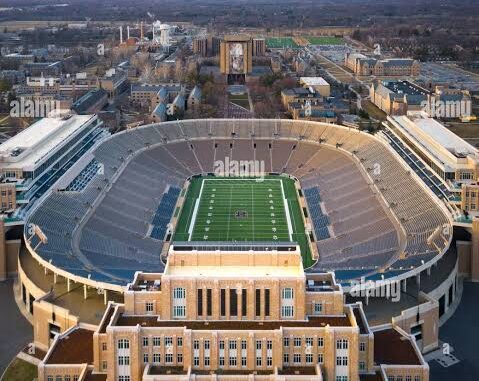
The University of Notre Dame has officially revealed a monumental $3.1 billion renovation to its iconic Notre Dame Stadium, redefining the landscape of college football and setting a new gold standard for fan experience, technological innovation, and university integration. This extensive project, known as the Campus Crossroads initiative, is the most ambitious in the university’s history and reimagines the stadium as not just a sports venue but a multi-functional academic, social, and entertainment hub.
At the heart of the transformation is a commitment to merging tradition with modernity. While preserving the historical character of Notre Dame Stadium—an emblem of college football for nearly a century—the renovation introduces a host of modern features aimed at enhancing the overall experience for students, athletes, faculty, and fans. Key structural expansions include three new buildings—Corbett Family Hall, Duncan Student Center, and O’Neill Hall—surrounding the stadium, each of which integrates academic and student life spaces with athletic facilities. These new buildings host everything from research labs and classrooms to fitness centers and lounges, reinforcing Notre Dame’s holistic approach to education and campus life.
For spectators, the upgrades promise a world-class game-day experience. The stadium now boasts wider, vinyl-clad seating to replace the traditional wooden benches, offering increased comfort even as overall capacity slightly decreases. Luxury suites, club seats, and loge boxes have been added, equipped with premium amenities such as gourmet dining options, private restrooms, and exclusive lounge access. These upgrades are designed not only to attract high-end patrons but also to enhance the overall atmosphere for all fans.
Technology is a cornerstone of the renovation. The installation of a massive 96-by-54-foot high-definition video board brings fans closer to the action with crystal-clear replays and visuals, all presented without commercial breaks. Ribbon boards lining the stadium offer real-time updates and stats, while an upgraded Wi-Fi system and enhanced cellular coverage ensure that attendees remain connected throughout events. This tech-forward approach aims to meet the evolving expectations of modern sports fans who want instant access to information and social connectivity.
Beyond athletics, the Campus Crossroads project reflects Notre Dame’s strategic focus on integrating athletics into the broader academic mission of the university. For example, the Department of Music and Sacred Music Program now resides within the stadium complex, encouraging interdisciplinary collaboration with other arts and performance departments. This unique melding of athletics, academics, and student services within a single footprint positions Notre Dame Stadium as more than a football field—it becomes a central part of everyday campus life.
In sum, this $3.1 billion renovation is far more than a facelift. It represents a redefinition of what a college football stadium can be: a place where tradition meets innovation, and where athletic excellence supports academic growth. By investing in cutting-edge technology, enhanced amenities, and integrated academic spaces, Notre Dame has created a blueprint for the future of college athletics—one that prioritizes both performance and purpose.
Leave a Reply